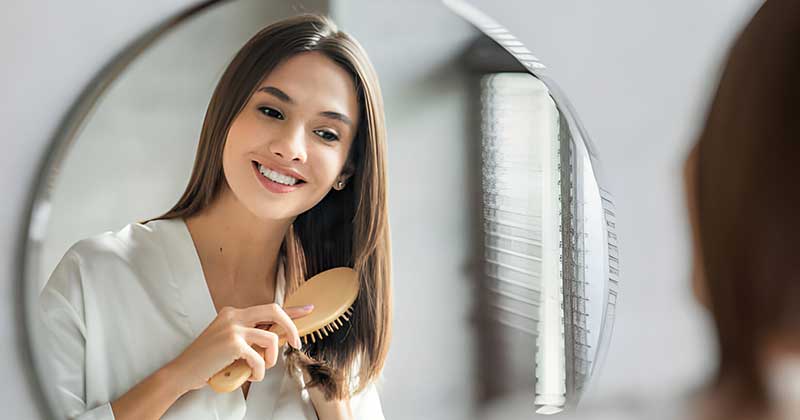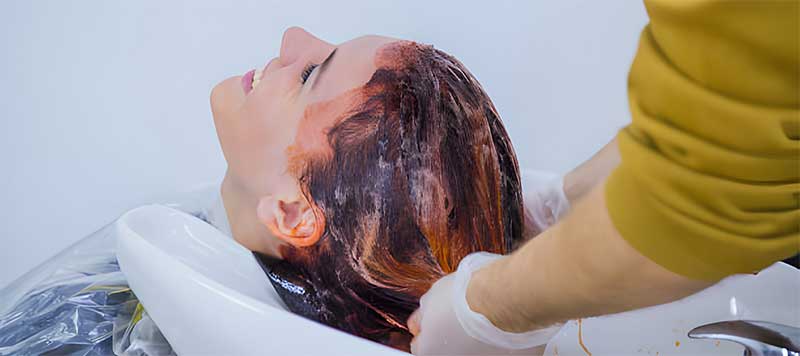
Caring for your hair holds significance for various reasons. Healthy, well-maintained hair can enhance your overall appearance. It’s often one of the first things people notice about you, and it can contribute to your self-confidence and self-esteem.
Hair serves as a natural barrier, protecting your scalp from the sun’s harmful UV rays, extreme temperatures, and environmental pollutants. Additionally, the oils produced by your scalp help moisturize and protect your hair strands.
Proper hair care can help prevent common issues like dryness, split ends, breakage, and dandruff. By keeping your hair and scalp clean and nourished, you can minimize these problems and maintain healthy hair.
Overall, taking care of your hair is essential for both its health and appearance. By adopting good hair care habits, you can enjoy stronger, shinier, and more manageable hair while promoting its long-term health and growth.
Establishing a proper hair care routine can support the growth of strong and healthy hair. Here’s a basic routine you can follow:
Regular Washing: Keep your scalp clean by washing your hair regularly with a mild shampoo. How often you wash depends on your hair type (dry, oily, normal), but typically 2-3 times a week is sufficient for most people. Avoid washing with hot water as it can strip away natural oils from your scalp, leading to dryness.
Keeping your hair clean every day without causing damage requires a balance between washing frequency and proper hair care practices. Use a mild shampoo that suits your hair type and scalp condition. Avoid shampoos containing harsh chemicals like sulfates, as they can strip away natural oils and lead to dryness. Concentrate the shampoo on your scalp rather than the lengths of your hair. Gently massage the shampoo into your scalp using your fingertips to remove dirt, oil, and product buildup.

If your hair tends to be oily, you may only need to apply conditioner to the ends of your hair to avoid weighing down your roots. If you have dry hair, focus on applying conditioner to the lengths and ends to moisturize and detangle.
On days when you don’t wash your hair, you can use dry shampoo to absorb excess oil and refresh your scalp. Apply it to the roots, massage it in, and then brush through your hair to distribute the product evenly.
To keep your hair cleaner for longer, consider wrapping it in a silk or satin scarf or using a silk pillowcase while sleeping. This helps reduce friction and prevents oils and dirt from transferring onto your hair.
By following these tips and adjusting your hair care routine to suit your specific needs, you can keep your hair clean and fresh without causing damage from overwashing or excessive manipulation.
Scalp Massage: Scalp massage can be an important aspect of hair care for several reasons. Scalp massage helps increase blood flow to the hair follicles, which can promote hair growth. Improved circulation ensures that hair follicles receive an adequate supply of oxygen and nutrients, which are essential for healthy hair growth.
Scalp massage can help relax the muscles in your scalp and alleviate tension and stress. Stress is known to contribute to hair loss and scalp issues, so reducing stress levels through massage may indirectly support healthier hair.
Massaging your scalp helps distribute natural oils (sebum) produced by your scalp evenly along the hair shafts. This helps moisturize and condition your hair, preventing dryness and promoting shine.
Gentle massage movements can help remove dead skin cells, product buildup, and excess oil from the scalp, which can improve overall scalp health and reduce the risk of dandruff and other scalp issues.
Massaging your scalp before applying hair care products can improve their absorption and effectiveness. This allows nutrients and active ingredients in shampoos, conditioners, and treatments to penetrate deeper into the scalp and hair follicles, maximizing their benefits.
While scalp massage can offer numerous benefits for hair and scalp health, it’s important to note that it’s not a standalone solution for addressing serious hair loss or scalp conditions. It should be combined with a comprehensive hair care routine that includes proper cleansing, conditioning, and nourishment. If you have specific concerns about your hair or scalp health, it’s always a good idea to consult with a dermatologist or trichologist for personalized advice and treatment options.
Choose the Right Products: Choosing the right hair care products involves considering several factors, including your hair type, scalp condition, specific concerns or goals, and personal preferences. Here’s a guide to help you choose the right products for your hair care routine:
- Identify Your Hair Type: Determine whether your hair is dry, oily, normal, curly, straight, fine, thick, or chemically treated (colored, permed, relaxed, etc.). Understanding your hair type will help you select products that cater to its unique needs.
- Consider Your Scalp Condition: Take into account any scalp issues you may have, such as dandruff, itchiness, sensitivity, or excessive oiliness. Choose products that address these concerns while also being gentle on your scalp.
- Know Your Hair Concerns: Are you looking to add moisture, combat frizz, boost volume, strengthen damaged hair, or promote hair growth? Identify your primary hair concerns so you can select products that target those specific needs.
- Read Labels Carefully: Pay attention to the ingredients list on hair care products. Look for high-quality, nourishing ingredients such as natural oils (coconut oil, argan oil, jojoba oil), vitamins (vitamin E, vitamin B5), proteins (keratin, collagen), and botanical extracts (aloe vera, chamomile, green tea).
- Avoid Harsh Chemicals: Steer clear of products containing harsh chemicals such as sulfates, parabens, phthalates, and silicones, which can strip away natural oils, irritate the scalp, and damage the hair over time. Opt for sulfate-free, paraben-free, and silicone-free formulas whenever possible.
- Choose pH-Balanced Formulas: Look for products that are pH-balanced, as they help maintain the natural pH of your scalp and hair, which is essential for optimal health and moisture balance.
- Test Products: If you’re unsure about a product, consider trying samples or travel-sized versions first to see how your hair responds before committing to a full-size purchase.
- Seek Recommendations: Ask friends, family, or hairstylists for recommendations based on their experiences with certain hair care brands or products. Online reviews and forums can also provide valuable insights into product effectiveness and performance.
- Consider Your Lifestyle: Factor in your lifestyle and styling habits when choosing hair care products. For example, if you frequently heat style your hair, look for products with heat protectant properties. If you lead an active lifestyle, opt for lightweight, non-greasy formulas that won’t weigh your hair down.
- Trial and Error: Finding the right hair care products may require some trial and error. Be patient and willing to experiment with different brands and formulations until you find what works best for your hair.
By considering these factors and tailoring your product choices to suit your hair’s specific needs and preferences, you can create a hair care routine that promotes healthy, beautiful hair.
Protect Your Hair: Protecting your hair is essential to maintaining its health, strength, and appearance. Here are some tips to help you protect your hair from damage:
- Limit Heat Styling: Excessive heat from tools like flat irons, curling irons, and blow dryers can weaken the hair shaft and cause breakage. Whenever possible, let your hair air dry or use heat styling tools on a low or medium heat setting. Always apply a heat protectant spray or serum before heat styling to minimize damage.
- Be Gentle When Wet: Wet hair is more prone to damage and breakage, so handle it with care. Avoid brushing or combing your hair aggressively when it’s wet, as this can cause stretching and breakage. Instead, use a detangling brush or a wide-toothed comb to gently remove knots and tangles.
- Protect from the Sun: UV rays from the sun can damage your hair, causing dryness, brittleness, and color fading. Wear a hat or scarf to shield your hair from direct sunlight, especially during peak hours. You can also use hair care products containing UV filters for added protection.
- Minimize Chemical Treatments: Chemical treatments like hair dyeing, bleaching, perming, and straightening can weaken the hair and cause damage if done too frequently or improperly. If you choose to undergo chemical treatments, make sure to follow the instructions carefully and consider consulting a professional stylist.
- Use Gentle Hair Accessories: Avoid using hair accessories that can cause friction or breakage, such as tight elastic bands, metal clips, and abrasive hair ties. Instead, opt for soft, fabric-covered hair ties, silk scrunchies, or hair-friendly accessories that won’t snag or pull on your hair.
- Protect at Night: To prevent friction and breakage while you sleep, consider using a silk or satin pillowcase or wrapping your hair in a silk scarf or bonnet. These materials are gentler on your hair and help maintain moisture levels while you sleep.
Trim Your Hair Regularly: While trimming won’t directly make your hair grow faster, it helps prevent split ends, which can lead to breakage and make your hair look thinner and shorter. Trim your hair once every 6-8 weeks to maintain its health.
Eat a Balanced Diet: Nutrients like vitamins A, C, D, and E, as well as minerals like iron and zinc, are essential for healthy hair growth. Make sure your diet includes plenty of fruits, vegetables, lean proteins, and healthy fats to provide your hair with the nutrients it needs to grow strong and healthy.
Stay Hydrated: Drink regular amounts of water to keep your body and hair healthy. Dehydration can make your hair dry and brittle, which can lead to breakage and slow down growth.
Be Patient: Remember that hair growth takes time, and everyone’s hair grows at a different rate. Be patient and consistent with your hair care routine, and you should start to see results over time. If you’re concerned about excessive hair loss or slow growth, consider consulting a dermatologist or trichologist for personalized advice.









